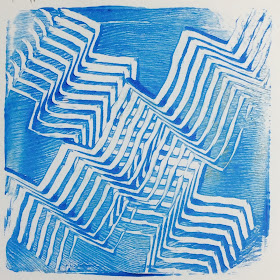At the AEAI fall convention this year, I went to a workshop about making monoprints with Gelli Arts. It was so fun, I ordered a set of Gelli plates for my classroom. The students loved it. I already had ink brayers, but I did purchase some decorating ribs, which look like combs, and some patterned stencils to make designs. A friend donated a roll of bubble wrap to my class, and that made nice designs as well! At the workshop I attended, we used little bottles of Folk Art acrylic paint, so I purchased a variety of small bottles of cheap acrylics, so each table could use several colors.
In class, I first shared some information on printmaking in general, with a slideshow of art by Gustave Baumann. I saw an exhibit of his work at the IMA recently, so I had interesting information and pictures. Afterwards, I mentioned other forms of printmaking, such as screenprinting, and described it. Then, I asked the class if they could guess what a "monoprint" was. To my delight, a student figured it out, because they had recently painted in a monochromatic color scheme, and knew that the prefix "mono-" means "only one"!
Then, I brought out a gelli plate, and demonstrated, and let a few students try it. They thought it was really cool! That was all we had time for in one 40 minute class session.
The next week, I had a gelli plate, ink brayer, square of bubble wrap, stencil, and a variety of decorating ribs on each table. Then, I let the each table go pick 4 colors of paint. My students sit 4 to a table, so they each grabbed one, and made sure they didn't have duplicates. I put the dots of paint on for them; when allowed to do it themselves, 5th graders put on waaaaaaay too much, and it doesn't work! Then, they students used the brayer to coat the gelli plate evenly, and then any variety of the tools I had available to make designs. After pressing their paper to the gelli plate, the students got another dot of paint for their next print. They took turns until class was over. Each student got about 3 prints done. We had some good color theory review as well; the students realized quickly that the complement of whatever color was used previously would mix with it to make brown!
Gelli printmaking can easily be adapted to different ages. I think middle school students would definitely love it. High school students probably would too; all the teachers I did it with at the AEAI convention had lots of fun! Younger students would just need more assistance.
If anyone else has used Gelli plates, please comment to let me know what you did, and how you liked it!
Here are a few student prints from my 5th graders.




































